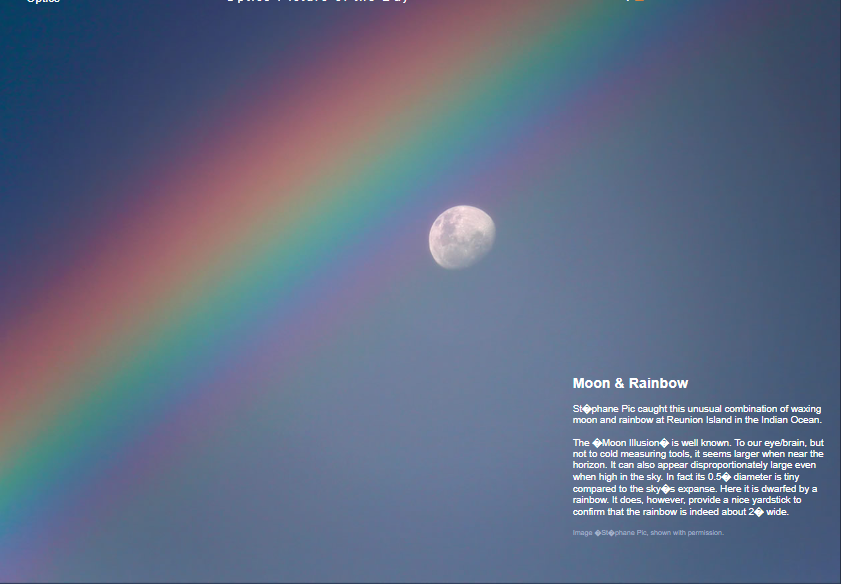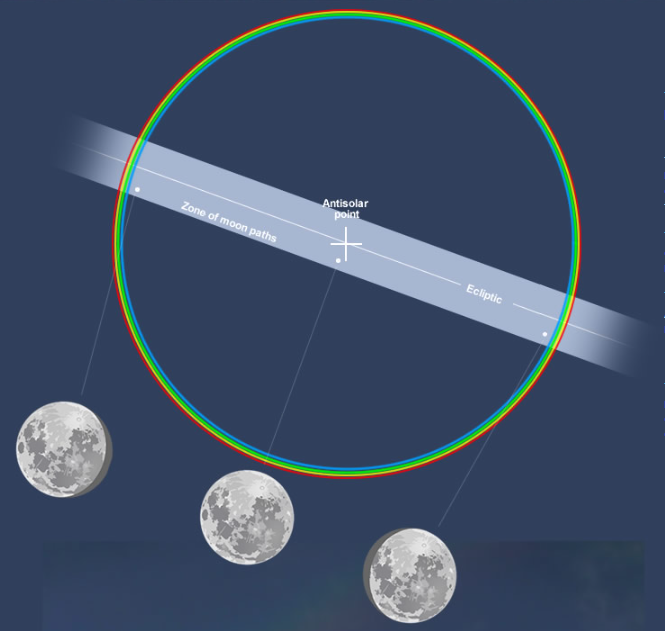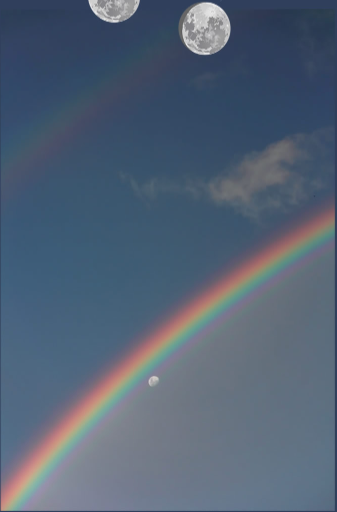OPOD - Moon & Rainbow
Moon & Rainbow: A Rare Combination of Nature's Beauty
Have you ever witnessed the breathtaking sight of a waxing moon and a rainbow together? Stéphane Pic captured this extraordinary combination at Reunion Island in the Indian Ocean. While the moon illusion is a well-known phenomenon, seeing it alongside a rainbow is a rare treat for the eyes.
The Moon Illusion: A Trick of Perception
To our eyes, the moon often appears larger when it is near the horizon compared to when it is high in the sky. This visual distortion, known as the "Moon Illusion," is not perceived by measuring tools that rely on cold, hard data. Despite its apparent size, the moon's actual diameter is just 0.5°, dwarfed by the vast expanse of the sky. However, when paired with a rainbow, the moon provides an excellent yardstick to gauge the width of the rainbow, which is approximately 2° wide.
The Moon and Rainbows: A Rare Encounter
The moon can only appear near a rainbow during specific phases, such as the waxing phase or its waning equivalent. This occurrence is due to the moon's path and its proximity to the antisolar point (ASP), which is directly opposite the sun. Rainbows, with a radius of approximately 42°, are centered at the ASP. When the moon is at its full phase, its path brings it close to the ASP each month. However, due to the inclination of the moon's orbit (~5° to the ecliptic), it rarely crosses the ASP.
The Moon's Constrained Path
The low inclination of the moon's orbit limits where it can intersect with a primary rainbow. The moon's path always follows a chord that is roughly parallel to the ecliptic, within 5° of it. This constraint means that the moon's rainbow crossing phase is consistently around 42° from full. Artists and photographers should take note to avoid depicting a crescent moon near a rainbow, as it would not be an accurate representation.
Factors Influencing the Angle
The image captured by Stéphane Pic reveals the moon with its northern pole pointing downwards. However, the angle of the ecliptic in relation to the horizon varies depending on the location, season, and time of day. These factors influence the alignment of the moon, rainbow, and other celestial phenomena, creating unique and captivating scenes for those fortunate enough to witness them.
Conclusion
The mesmerizing combination of a waxing moon and a rainbow is a rare occurrence that showcases the beauty and wonder of atmospheric optics. Despite its small size compared to the vastness of the sky, the moon serves as a useful reference point to appreciate the width of a rainbow. The moon's path and the inclination of its orbit limit the opportunities for it to intersect with a rainbow, making such sightings even more special. As nature continues to surprise us with its harmonious displays, we can only marvel at the intricacies of our planet's atmosphere and the captivating interactions between light and celestial bodies.

Moon & Rainbow
St�phane Pic caught this unusual combination of waxing moon and rainbow at Reunion Island in the Indian Ocean.
The �Moon Illusion� is well known. To our eye/brain, but not to cold measuring tools, it seems larger when near the horizon. It can also appear disproportionately large even when high in the sky. In fact its 0.5� diameter is tiny compared to the sky�s expanse. Here it is dwarfed by a rainbow. It does, however, provide a nice yardstick to confirm that the rainbow is indeed about 2� wide.
Image �St�phane Pic, shown with permission.

The moon can only ever appear near a rainbow with this phase or the equivalent waning one.
Rainbows are ~42� in radius and centred directly opposite the sun at the antisolar point, ASP. The moon�s path takes it near to the ASP each month at full. That it almost never crosses the ASP is because the moon�s orbit is tilted ~5� to the ecliptic, the plane of Earth�s orbit around the Sun.
The low 5° inclination of the Moon�s orbit constrains where it crosses a primary rainbow. Its path is always on a chord very roughly parallel to the ecliptic and within 5° of it.
The moon's rainbow crossing phase is always ~42° from full. Artists � beware of showing a crescent Moon near a rainbow!
The image was taken in the Southern Hemisphere and the moon has its northern pole downwards. The angle of the ecliptic to the horizon depends on location, season and time of day.

Note: this article has been automatically converted from the old site and may not appear as intended. You can find the original article here.
Reference Atmospheric Optics
If you use any of the definitions, information, or data presented on Atmospheric Optics, please copy the link or reference below to properly credit us as the reference source. Thank you!
-
<a href="https://atoptics.co.uk/blog/opod-moon-rainbow/">OPOD - Moon & Rainbow</a>
-
"OPOD - Moon & Rainbow". Atmospheric Optics. Accessed on April 20, 2024. https://atoptics.co.uk/blog/opod-moon-rainbow/.
-
"OPOD - Moon & Rainbow". Atmospheric Optics, https://atoptics.co.uk/blog/opod-moon-rainbow/. Accessed 20 April, 2024
-
OPOD - Moon & Rainbow. Atmospheric Optics. Retrieved from https://atoptics.co.uk/blog/opod-moon-rainbow/.